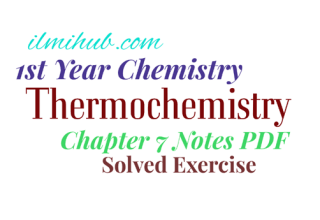In this post, I am sharing FSC 1st Year Chemistry Chapter 8 Short Questions Notes PDF for the students of FSC Part 1. The name of 11th Chemistry Chapter 8 is Chemical Equilibrium. So the students can download Chemical Equilibrium Chapter Short Questions in PDF format from here. This file contains only 08 pages. These Chemistry Notes are for all the boards working under Punjab Board like Gujranwala Board, Lahore Board, Faisalabad Board, Multan Board, Rawalpindi Board, Sargodha Board, DG Kahn Board, and Sahiwal Board. Here are the complete 1st Year Chemistry Notes.
11th Class Chemistry Chapter 8 “Chemical Equilibrium” Short Question PDF Download
Differentiate between reversible and irreversible reactions.
| Reversible Reaction | Irreversible Reaction |
| Those chemical reaction which can move in both directions (i.e. forward and reverse) under same conditions are called as reversible reactions | Those chemical reactions, which can proceed only in the forward direction in the given conditions, are called as irreversible reactions. |
| These reactions are represented by a double headed arrow | These reaction are represented by a single arrow, pointing from reactants towards the products |
| A reversible reaction, always stop at the equilibrium point. | Irreversible reactions, always goes for competition. |
| At equilibrium stage both the reactant and the product are present in the reaction mixture | All the reactant are converted into product. |
Define buffer capacity.
The buffer capacity of a solution is defined as.
“ the ability of a buffer solution to resist the change in its pH, when an acid or base is added to it”.
Generally, the buffer capacity of an acidic buffer for a base is equal to the concentration of weak acid present in the buffer solution and for an acid is equal to the concentration of salt present in the buffer solution.
A catalyst does not affect the equilibrium constant comment on it?
A catalyst does not affect the equilibrium constant of a chemical reaction, A catalyst increase the rate of both forward and backward reactions and reduces the time to attain the state of equilibrium. The concentration of reactant and the products at equilibrium remain same.
As,
Kc = [Products]/ [Reactant]
Since concentrations of reactant and product are not affected, the equilibrium constant (Kc) remain constant
How equilibrium constant ‘Kc’ is used to predict the direction of reaction.
The direction of a chemical reaction at any particular time can be predicted by means of [Products]/[Reactant] ratio, calculated before the reaction attains equilibrium.
[Products]/ [Reactant] = ratio
Relevant Notes
- 1st Year Chemistry Chapter 1 Short Questions Notes PDF
- 11th Chemistry Chapter 2 Short Questions Notes PDF
- 1st Year Chemistry Chapter 3 Short Questions Notes PDF
- 1st Year Chemistry Chapter 4 Short Questions Notes PDF
- 1st Year Chemistry Chapter 5 Short Questions Notes PDF
- 11th Chemistry Chapter 6 Short Questions Notes PDF
- FSC 1st Year Chapter 7 Short Questions Notes PDF





